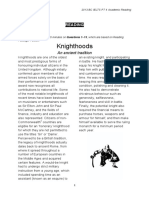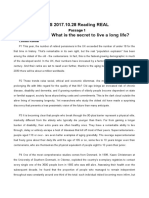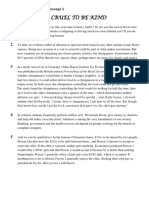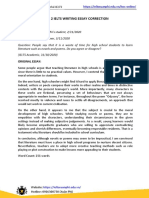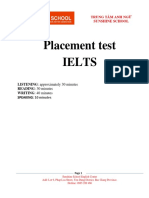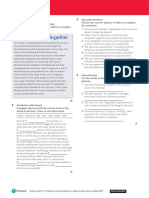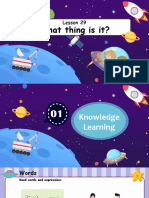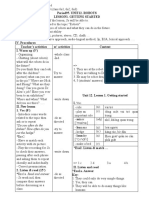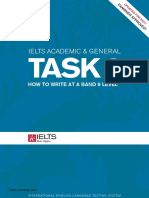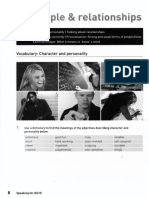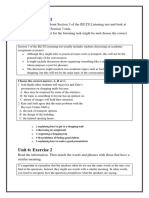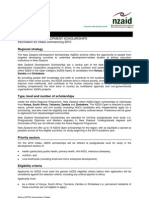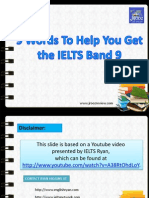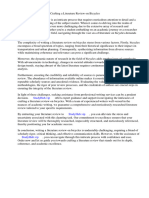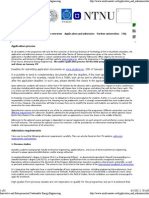IELTS Introduction TB - Unit 1 - Finding Out About The World
IELTS Introduction TB - Unit 1 - Finding Out About The World
Uploaded by
Thọ BùiCopyright:
Available Formats
IELTS Introduction TB - Unit 1 - Finding Out About The World
IELTS Introduction TB - Unit 1 - Finding Out About The World
Uploaded by
Thọ BùiOriginal Description:
Original Title
Copyright
Available Formats
Share this document
Did you find this document useful?
Is this content inappropriate?
Copyright:
Available Formats
IELTS Introduction TB - Unit 1 - Finding Out About The World
IELTS Introduction TB - Unit 1 - Finding Out About The World
Uploaded by
Thọ BùiCopyright:
Available Formats
1 Finding out about the world
Content overview
Themes Speaking
This unit acts as an introduction to the different parts of Part 1 Talking about transport
the IELTS exam and is thematically focused on finding Part 2 Talking about places you like to visit
out about the world.
Language development
Exam-related activities Language focus and Vocabulary
Reading Places to visit
Skimming Talking about the present
Matching headings Word building: Adjectives for describing places
Identifying information: True/False/Not Given Past simple
Choosing items from a list
Short-answer questions Skills development
Writing
Reading
Task 1 Describing a chart
Skimming
Listening
Study skills
Section 1
Listening: Numbers and letters
Numbers and letters
Writing/Describing: rise and fall
Multiple choice
Choosing items from a list
Sentence completion
Sample answers
Vocabulary 1 page 6 A The place is very green with lots of trees and a river or
stream. It is very wild and looks an exciting place.
B There is a beautiful blue sky with a palm tree and a beach
Places to visit with white sand. The sea is blue/green. It looks very
Aim relaxing.
The aim of this section is to introduce students to vocabulary C Its really built-up with a very modern building, which
that will be useful throughout the unit, especially for might be a museum. Its an exciting-looking building.
Speaking Part 2 on page 11. D Its got a huge mountain with snow on the top. Its
perhaps a volcano.
Pre-activity
Before students open the book, put pictures of different 2 Check the answers as a whole class and draw students
places on the board and elicit adjectives to describe these attention to the additional vocabulary on the board.
places. Write these in a column down the side of the board Check comprehension by asking students to explain
and check pronunciation. their answers.
1 Ask students to look at the pictures in the book. Answers
Working in pairs, they can use some of the vocabulary 1 C 2 A 3 B 4 D
on the board and add some of their own if they wish.
As you monitor the students, add any useful new 3 If necessary, drill the question and different answers.
words you hear to the list on the board. Then students practise in pairs.
10 Finding out about the world 1
9780230425750.Text.indd 10 20/02/2012 15:06
4 Students can do this individually. Tell them not to
worry if they dont know all the vocabulary at this Listening 1 page 7
point. They should predict the answers using the
words they know. If necessary, allow students to use a
dictionary. Numbers and letters
Answers Aim
This section aims to give students practice with listening to
1 garden grass, flowers, plants, birds
and saying numbers and the letters of the alphabet, which is
2 beach sea, waves, shells, sand dunes
useful for the Listening module.
3 countryside trees, fields, rivers, lakes
4 city roads, offices, museums, theatres Suggestion
5 mountain rocks, valley, cave, waterfall As a class awareness exercise, put students into groups and
ask them to make a list of a maximum of seven difficulties
5 Before students check their answers in pairs, elicit the they may have in dealing with numbers or the alphabet in
meaning of unknown words. Encourage students to
English. For example, there might be confusion between
keep an electronic or hard copy vocabulary book. You
writing the numbers in English for Farsi speakers, eg, a
could suggest they make a page headed Places and
confusion between 6 in English, which is written like a 7 in
you might like to show them how to do a spidergram
Farsi. If the class is monolingual, follow the same process.
or mind map. Tell them that grouping words under
subjects is a more efficient way of recording words than 1 Go over the instructions, using the first item as an
alphabetical lists. Throughout the course, check that example or eliciting some numbers and letters from
students are updating their vocabulary books. students. Let them work out the others in pairs and
then get class feedback. Illustrate how FFF might be
6 Tell students to do this exercise individually and then said as double ef ef; 66 as double six, etc. Ask students to
check their answers in pairs. Point out that there is
identify sounds that may be ambiguous, eg, W = double
more than one answer.
u not vee/wee. You might like to do choral drilling here.
Answers Keep a record of some specific problematic areas of
1 beach/sand dunes; waves/sea pronunciation and focus on them throughout the
2 rocks course. As a whole class, students can make a list of
3 countryside the alphabet and the pronunciation of the letters. They
4 theatres can do the same for numbers and add the lists to their
5 garden; birds vocabulary books.
7 Ask students to make the questions individually after 2 As an example, dictate one or more of the items 16
putting the examples on the board and reviewing from exercise 1. Use an appropriate speed for this
question forms. Monitor students and give help where level. To check comprehension, ask students to dictate
necessary. They can then ask and answer questions sequences of numbers and letters for you to write on
in pairs while you monitor and correct any mistakes. the board.
Encourage several pairs of students to answer the 1.1 Play the recording once and let students
3
questions in their own words as a demonstration for
fill in the spaces individually. After comparing their
the whole class.
answers in pairs, students can listen again to check
Extension their answers. To monitor comprehension, ask selected
As an extra exercise at the end of the section, students can students to read the completed notes.
work in pairs or groups. One student describes somewhere
Answers
famous in the world, eg, New York, Paris or somewhere local
that everyone knows, and the other student(s) has(have) to 1 TLM 19772
guess where it is. 2 XY331373TV
3 07967 55 33 79
4 49
5 BE5 9KV
1 Finding out about the world 11
9780230425750.Text.indd 11 20/02/2012 15:06
Point out that they will not get extra marks if they tick four
1.1 items.
0 flight number TA5557 Questions 9 and 10: Sentence completion
1 flight number TLM 19772 Ask students to look at the gaps and predict the type of
2 booking reference XY331373TV word that is missing, eg, noun/verb/number, etc, and
3 mobile number 07967 55 33 79 the word itself.
4 My address is 49 Malory Park. Now play the recording all the way through once,
5 The code is BE5 9KV. monitoring which questions students are having difficulty
with. Get them to check their answers with their partner.
Play the recording again so they can fill in any questions
Listening 2 page 7 they missed previously. Again, they check their answers
in pairs. Finally, play the recording a final time, stopping
at each answer on the CD to check. Make sure students
IELTS Listening Section 1 understand the answers and explain the textual clues that
help. Ask them to add up their scores and make a note of
Aim the question types they found more challenging.
This section aims to introduce students to the first section of
the IELTS Listening module. Answers
1 B 2 B 3 A 4 C 5 B
Suggestion
68 A, B, D
To help students develop their listening skills, encourage
9 3/three
them to listen to different types of listening material, not just
10 ZB7334921G
material that is available for IELTS. If your school has a resource
centre, arrange a visit specifically to introduce students to
the listening material available. Encourage students to do one 1.2
listening exercise, no matter how short, each day. (A = Ann; J = John)
Some students may feel nervous about listening, so it is A: Hi, John, is that you?
important to build up their confidence as early as possible in J: Yes. Ann?
the course. A: Yes, its me. Did you pack everything last night?
J: Yes, I did. But Im just putting the last few things in my suitcase
Exam information here at work, like books and things.
In the IELTS Listening module, there are four sections. A: Its really exciting. I cant wait to get there.
Sections 1 and 2 are usually about social topics, while J: Me neither.
Sections 3 and 4 are more academic. There are 10 questions A: I had a look at the weather forecast for the holiday and it looks as
in each section. Students need to use correct spelling in their if its going to be wonderful. Its going to be 30 degrees Celsius
answers. and sunny with no clouds at all.
J: Thats fantastic!
1 1.2 Go over the Exam information on page 8 A: Yeah! The beaches there are marvellous with white sand, large
sand dunes and blue sea and no offices or skyscrapers. We can
carefully and check students understand the format. spend some time on the beach. Its very relaxing.
Regarding the Strategy, they should underline key J: Definitely. So dont forget your sun cream. When Im on holiday I
words in the preparation time given before the always lie on the beach and read books and listen to music. Then
dialogue starts. I do some shopping and I eat a lot; in fact, I do all the things that I
dont really have time to do here.
Explain to students that they will always have 3040
A: Me too, but I want to visit a few historical sites as well.
seconds before the dialogue starts. They should use
J: As you know, youll have to do that on your own! I just lie around
this time wisely to find key words in the questions and and do nothing.
underline them. A: No problem. I find it difficult just sitting or lying around all day
Questions 15: Multiple choice doing nothing at all.
Use the example to show how to look at the distractors, J: Yeah. OK. So where shall we meet and when?
find the differences between them, and see how they A: I think its best at the airport itself. Lets meet on the departure level.
relate to the stem. In this case, the differences are in the J: But where?
tenses and negative/positive words used. A: Well, theres a shopping area just on the left as you come to the
departure level.
Questions 68: Choosing items from a list J: Yeah. I think I know it.
Ask students to put a box around three in the rubric. A: And the first restaurant as you go in on the left is Chinese. Its got
Encourage them to box numbers or important information this map of China with one big star on it.
in the rubrics throughout the course and in the exam. J: Are you sure I wont miss it?
12 Finding out about the world 1
9780230425750.Text.indd 12 20/02/2012 15:06
A: You wont. I cant remember the name, but anyway, well have Suggestion
our mobile phones. Point out to students that they do not have to give long
J: Yes, so no need to worry. answers for this section, perhaps no more than one or
A: OK. What time then? two sentences. To help students to get used to answering
J: Say 5 pm? questions rather than just describing things, you can elicit
A: But the plane doesnt depart until 8 oclock. two or three extra questions about transport or places, write
J: Yes, but we are supposed to be there two hours before check-in them on the board and ask students to ask each other the
and baggage checks. That can take a good hour at least.
questions. Take feedback on the answers students give.
A: Yeah. I suppose so.
J: One thing. Do you think that theyre strict about the baggage Exam information
allowance? Part 1 takes between four and five minutes. Both the
A: Yes, I think so. Were only allowed 25 kilograms each. students and the examiner introduce themselves. The
J: I thought it was more. examiner will check some basic information (name/
A: Try putting some heavy things in your hand luggage, but dont nationality) and then he/she asks the students about
overdo it!
themselves, their family, their job/studies, their interests and
J: Yeah; thats an idea.
a variety of familiar topics.
A: Remember not to forget your passport and currency. You know 1 Go over the Exam information with students, giving
what youre like about things like that. some examples of the types of questions the examiner
J: I wont. Ive already packed them! will use to find out basic information.
A: Dont forget the mmm ... the guidebook! Students can also do the exercise individually and
J: Oh yes. Its still in the drawer here at work. Im getting it out now check their answers in pairs before whole-class
as were talking. Just as well you reminded me.
checking. Ask individual students the questions.
A: I knew youd forget something!
Monitor their answers for pronunciation and
J: So what time are you leaving the flat?
intonation.
A: Mmm I think Id better leave about three.
J: Yeah, thatll give you plenty of time. I can leave work at three if I Answers
want, but as were not that far from the airport, it wont take me
as long. So, Ill leave the office at about four. 1 name 3 country 5 transport
A: Are you sure thats going to give you enough time? 2 Where 4 types/methods
J: Yeah, plenty.
2 You can ask students to use their own answers for
A: OK. And whats the ticket reference?
the questions. Monitor their answers and elect some
J: Yes, we need the ticket reference to collect the tickets from the
stronger students to model good responses to the class.
machine. Here it is, in my diary. Its ZB7334921G.
A: I think Ill write it down too just in case. ZB7334921G. Is that right?
J: Yes, thats it.
Language focus 1 page 8
Review
Play the recording again so students can listen to check
comprehension. Weaker students can listen and read the script Talking about the present
at the same time, if necessary. To help students practise for the
exam, they can transfer their answers to a sheet of paper. Check
that the spelling is correct. Write the answers on the board.
1/2 Go through the questions as a class and ensure
students understand the differences between the
form and function of the two tenses here. For more
information, refer them to the Grammar on page 150.
Speaking 1 page 8
Answers
1
IELTS Speaking Part 1 1 present continuous
2 present simple
Aim
2 The present simple relates to habit and the present
This section introduces students to the first part of the
continuous relates to a temporary action.
Speaking module.
3 Check the answers as a class. Ask students to explain
the answers to you to check comprehension.
Answers
1 d 2 e 3 a 4 b 5 c 6 f
1 Finding out about the world 13
9780230425750.Text.indd 13 20/02/2012 15:06
4 Check the answers with the whole class, eliciting the Sample answer
reasons for the correct alternatives. The place is relaxing and pleasant. It is exciting because it
is very wild. It is also very beautiful.
Answers
1 do people get 4 is touring 3 Before students complete the table in pairs, ensure
2 departs 5 dont swim they are familiar with the column headings. Monitor
3 is happening 6 are having for spelling at this point and check the meaning of the
words.
5/6 If necessary, go over the Grammar on page 150 again
before students do the rest of the Language focus Answers
exercises. 1 excitement 7 relaxation
Monitor students as they complete these exercises and 2 appealing 8 attractive
ensure their justifications for their decisions are logical. 3 appeal 9 attraction
4 boredom 10 impressive
Answers 5 interesting 11 impression
1 reads; read (a a habit/repeated action) 6 interest
2 eat (a a habit/repeated action); is becoming (e a
4/5 Students can do exercise 4 individually and then check
temporary action (happening at this moment))
in pairs before whole-class checking. As students do
3 do not fly; travel (a a habit/repeated action)
the pairwork in exercise 5, monitor for accuracy and
4 Do you watch (a a habit/repeated action)
give feedback.
5 study (a a habit/repeated action); am/m taking (f a
temporary action happening around now) Answers
7/8 Monitor students for pronunciation and intonation 1 relaxing/peaceful
in 7. If necessary, do the additional exercise on page 2 excitement
150. To review this section, read the statements 16 in 3 impressive/thrilling/interesting
exercise 3 aloud and ask students to name the tense and 4 appeal/attraction
explain why it is used. 5 interest
6 relax
Answers 7 boring/dull
1 What are you studying at the moment? Review
2 Where do you spend your time in the holidays? To review the section, give students an adjective and ask
3 Are you learning a language at the moment? them to tell you a related noun or verb. Remind them to add
4 Do you lie on the beach when you are on holiday or do any new words to their vocabulary books, with examples of
you go to museums? the context. Point out how word forms can help in guessing
5 How do you travel to class each day? the meaning of new words.
Extension
Vocabulary 2 page 10 To check comprehension at the end of the section, write a list
of short sentences on the board with a mixture of adjectives,
some from the table in exercise 3 and some adjectives
Word building: Adjectives for describing physical attributes. Ask students to distinguish
between the two types of adjectives.
describing places
Aim
The aim of this vocabulary section is to prepare Speaking 2 page 11
students for the next section, Speaking Part 2, so that
students can describe how they feel about a place as
well as describing it physically. IELTS Speaking Part 2
1/2 Give students time to look at the picture and come Exam information
up with adjectives, which you can write on the board. In Part 2 of the Speaking module the examiner gives students
During feedback, add new adjectives to the list already a card with some prompts. They are usually asked to talk
on the board. about a person, an event, a place or an object. They have 1
minute to make notes and then speak for 12 minutes. The
examiner does not ask them any questions.
14 Finding out about the world 1
9780230425750.Text.indd 14 20/02/2012 15:06
1 Go over the Exam information and explain the Suggestion
procedure. Look at the sample Task Card and point out To help build students awareness of the exam, focus on one
the question words used. These are typical and each type of question that has been introduced, eg, paragraph
one needs to be answered. Encourage students to talk or section headings. Elicit the structure of the headings,
about each prompt in order. Ask them to do the activity the types of words used, whether they are like newspaper
in pairs, then check as a class. headings, whether they use sentences or phrases, what
types of phrases (usually noun phrases) are used, and why
Answers these phrases are used.
Describe somewhere that you like to visit. lake
where the place is countryside Exam information
when you visit the place weekends In the Reading module there are three reading passages,
who you visit the place with friends with a maximum of about 2,700 words in total. Each passage
why you like the place. relax, study, has 1214 questions.
impressive,
appeal,
attractive, Pre-reading
peaceful 1 When explaining the Exam information, show students
2/3 Students complete the gaps individually and check a sample text so they can see what the length looks
their answers in pairs and then as a whole class. Elicit like. Discuss the exam Strategy. Stress that they may
the meaning of any unknown words. Students do not have time to read the whole passage in detail in
the underlining in 3 as a pairwork activity. Check the the exam, so they need to learn to skim. Point out that
answers as a whole class. the title and the questions 113 are a summary of the
reading passage. They can also skim the questions
Answers before they skim the passage.
2 These pre-reading strategies are extremely important
1 lake 6 relax to develop efficient reading skills. Go over them one by
2 countryside 7 study one and ask students to justify their answers.
3 weekends 8 appeal
4 friends 9 attractive Answers
5 peaceful 10 impressive Section A
3 1 Yes. Africa.
Sample answers 2 Yes. Yes.
1 Id like to describe Section B
2 Some people find 1 Yes.
3 it is a good place to 2 Yes. No.
4 appeal to me a lot Section C
5 Another reason I find the place attractive 1 The people.
2 Because rock art was made so long ago, we do not know
4 The words to stress here are brief notes. Remind them who the earliest artists were. However, there are some
they only have a minute. Time students as they write exceptions to this. We know that most of southern Africas
and ask them to count their words. rock art was made by ancestors of modern San people.
In North Africa, we know that the earlier art, dating from
5/6 Before students start, elicit what they need to listen for more than 7,000 years ago, was made by people who
and give feedback on. Ask one or two students to talk
hunted and gathered wild food. Paintings, including
about the card to the class. Then give your own example.
those of cattle dating from between 7,000 and 4,500
years ago, may have been made by ancestors of Black
West Africans. Much of the art of the last 3,500 years,
Reading page 12 particularly the engravings of Niger and Mali, was
produced by ancestors of the Amazie people.
Aim Section D
The purpose of this section is to introduce students to 1 Possible explanations.
the Academic Reading module. The reading passage is 2 Rock art is the only way we can tell how our ancestors
considerably shorter than passages students will encounter thought and how they saw their world. However, because
in the IELTS exam. The vocabulary has been simplified, but most rock art belonged to cultures that disappeared
the text structure has not been changed and the format of the long ago, it is now difficult to understand why the artists
exam questions remains the same. painted and carved, or what their art meant to them. Many
1 Finding out about the world 15
9780230425750.Text.indd 15 20/02/2012 15:06
researchers believe that the art had religious connections,
expressing the artists thoughts of reality and their position Language focus 2 page 14
in the world around them.
It must have been a means of communication, but
with whom? Bushmen artists showed their visions of a Past simple
combined natural and spiritual world. Did they do this to 1 After students have answered these questions, put the
tell others what they saw during dream-like states or was form on the board, or, if they seem quite familiar with
it a means to contact the earths spirit and control nature? the past simple, get one or two students to write it on
During the 20th century in eastern and central Africa, the board. For further information, refer students to the
people used and still use rock paintings to bring rain, Grammar on page 150.
strengthen themselves and assist their souls through those
difficult moments of birth, becoming adults, sickness and Answers
death. Perhaps our modern beliefs have ancient origins. 1 both irregular
2 You use did you/he/she/it we/they before the infinitive
Reading without to:
Did you pack everything?
2 As in the Listening module, encourage students to With question words:
underline key words in the questions. Introduce each What/When/Where/How/did you ...?
question type separately before moving onto the next With who as the subject of the verb:
one so they get an introduction to the different skills Who packed (your suitcase)?
necessary. Refer students to the Glossary. 3 you use the did + not/nt + the infinitive without to
Questions 14: Matching headings I did not/didnt (pack my suitcase).
Ask students to underline words like how and nouns 2 This exercise can be completed in pairs, followed by
such as overview and extent. These give them some idea class feedback.
of the general information in the paragraph. They can
then underline the words relating to content, such as Answers
rock art and preserved, which will help them scan. Section A
Questions 58: Identifying information True/False/ ... were over 8 metres high ...
Not Given ... were very well made ...
Indicate the differences between these and point out that ... people who had no knowledge ...
they have to be careful with False and Not Given. During were made
checking, ensure students understand the reasons why Section C
answers are given and where to find them in the text. who the earliest artists were ...
Questions 911: Choosing items from a list by people who hunted and gathered ...
Note the number of letters needed and key words in Section D
the items. ... thought and how they saw their world ...
belonged to cultures that disappeared
Question 12 and 13: Short-answer questions why the artists painted and carved, or what their art
Note the word limit. Tell students they can use the meant
answers to the matching headings section to help them the art had religious connections
locate these answers in the text. showed their visions
When students have finished answering the questions, Did they do this
ask them to select 710 words from the reading was it a means
passage that they think are useful to remember. Write people used
them on the board with some context to help them to
remember the words. They can then write them in their 3 Once students have finished this exercise and checked
vocabulary books. their answers in pairs, ask them to identify regular and
irregular verb forms.
Answers
Answers
1 Section A iv 7 Not Given
2 Section B v 8 True 1 made; went 5 wrote; went
3 Section C vi 1012 A, C, D 2 Did (you) have; were 6 did (you) visit; stayed
4 Section D iii 13 religious connections 3 did (the air fare) cost 7 didnt fly; caught
5 False 14 ancient origins 4 grew
6 False
16 Finding out about the world 1
9780230425750.Text.indd 16 20/02/2012 15:06
4/5 Once students have done exercise 4, to check the exam rubric or instructions and the graph using
comprehension, select several students to answer the statements 18. Point out that the rubric is typical of
questions. Alternatively, students can ask you the rubrics they will see in the IELTS exam. Emphasize the
questions. If necessary, chain drill the questions around words summarize, main features and comparisons.
the class to check for intonation and linking, before
Answers
students do the pairwork in 5.
1 a graph
Answers 2 percentages
1 What were your favourite games when you were young? 3 Europe, North America and All other countries
2 How did you spend your weekends when you were at 4 1993 to 2007
secondary school? 5 illustrates
3 Why did you start to learn English? 6 summarize the information
4 Did you live in a town or the countryside when you were 7 main characteristics
a child? 8 more
5 Who did you most admire when you were young?
6 What hobbies did you have as a child?
2 Ask students to match the phrases under each heading
to the graph and to justify their answers. Check the
answers as a whole class.
Writing page 14
Ask students to write columns headed rise, fall, go up
and down in their vocabulary books. As they work
through the next seven activities, they can add words
to the appropriate columns.
IELTS Writing Task 1
Answers
Aim
This section introduces students to their first attempt at 1 b 2 c 3 a
interpreting data. At this level, do not expect students to
write an exam-length answer.
3/4 Go through these carefully when students have
done the activities, and stress how this is essential
Suggestion vocabulary for Task 1.
To help familiarize students with using data, you can use
Answers
information gap activities as in the pairwork exercises in the
photocopiable activity on page 110. rise: peak, increase, climb, go up, hit a peak, grow
fall: drop, dip, became less popular, hit a low, decrease,
Exam information decline, go down
In Task 1, students are asked to describe a graph, a chart, go up and down: fluctuate, rise and fall, vary, be erratic
a map, a diagram of how something works, or a process.
Sometimes there is more than one set of data, but the 5 Point out to students the importance of learning the
different sets are always connected in some way. Students nouns that can be made from verbs and vice versa.
need to write a minimum of 150 words and write in Encourage them to use both in writing and speaking.
paragraphs. If they do not, it will affect their score. The Stress that using synonyms accurately, and different
introduction needs to paraphrase the description in the forms of the same root, is a good writing strategy.
instructions.
Answers
1 Go over the Exam information with students. Show rise, peak, increase, fall, drop, dip, decrease, decline
examples of the different types of data that are common
in the exam: line graphs, bar charts, pie charts and tables. 6 Elicit the examples from students and ask them to
explain their answers.
Students could be encouraged to write new words in
their vocabulary books under a new heading of Task 1. Sample answer
Go through the Strategy box with students, stressing peaked at about 62 per cent around 1998
the importance of not writing about everything, just fell significantly between 1999 and 2007
the most significant points. Draw their attention to fluctuated between 30 per cent and 40 per cent
the Tip and point out that numbering, circling and
drawing arrows on the diagram can help them plan 7 When you have checked the answers, match the
their answers. description to the graph in exercise 1. Ask a student to
read the completed text aloud.
Students can do this exercise in pairs. Check the
answers as a whole class and ask them questions about
1 Finding out about the world 17
9780230425750.Text.indd 17 20/02/2012 15:06
Answers
1 provides information about 5 1.3 After checking the answers, allow students
2 became less popular to listen again to the recording. Ask one or more
3 fell significantly students to read the items aloud.
4 55% to just under 40%
Answers
8 Elicit from students how to transform this into a verb 1 GV976 5 PB3379132F
phrase: ... dipped ... 2 907776; 22 6 27
3 07551 66 63 33 7 17.40
Answer
4 24
there was a dip in ...
9 When students have done this, select some students 1.3
with good examples to write them on the board. 1 Flight number GV976 to Baghdad will depart from gate ...
2 The 907776 flight to Paris will depart from gate 22.
3 07551 66 63 33 is my mobile number.
Photocopiable activity page 110 4 Catch the bus number 24.
5 The booking reference is PB3379132F.
6 The flight will depart from gate number 27.
Spot the differences 7 That will cost 17.40.
If your students are less able, you can let them look at
each others graph to check the differences. Encourage Writing/Describing: rise and fall
students to ask each other questions rather than
just describing. You can also ask students to write a 1/2 Emphasize how useful this vocabulary is, particularly
description of one of the graphs as additional writing for Writing Task 1.
practice.
Answers
Answers 1
see page 123 1 F 2 R 3 F 4 R 5 F 6 R 7 R 8 F
2
ticked verbs: plunge, jump, dive, leap
Study skills page 17
3 If students do this in class, get them to write their
sentences on the board. Draw their attention to the
tense.
Listening: Numbers and letters
Alternatively, you can use the final section of each unit
1 Explain that certain numbers can cause confusion as a self-study task if you feel your students are able to
when hearing them. Sometimes, it is easy to know from cope with this. You can advise them to do this in their
the context. Say some examples ending in -teen and -ty own time as a review activity for the skills learnt in the
13/30; 14/40, etc, and get students to identify them. unit. Give students a time limit for self-study at the
Then put some numbers on the board and get them to beginning of the course and encourage them to make
say them clearly as you point to them. They can then study plans and record their achievements and areas
practise this in pairs. where they need to do some extra practice.
2/3 As a follow-up, ask students to dictate numbers and You can check this either as a whole class the next time
letters for you to write on the board. you meet, or you can provide an answer key for them
to self-check. The latter gives more learner autonomy,
4 Review the sounds of the alphabet. If you have but for the first two or three units, students may need
students whose language does not use the Roman some guidance if they are not used to this method of
alphabet, they may have pronunciation problems. learning.
There may also be some false friends for students
whose first language uses the Roman script. Monitor
students and give feedback on errors.
18 Finding out about the world 1
9780230425750.Text.indd 18 20/02/2012 15:06
You might also like
- (IE3) - Unit 1 - Urban and Rural Life - ListeningDocument6 pages(IE3) - Unit 1 - Urban and Rural Life - ListeningThắm MèoNo ratings yet
- IELTS Reading Mock TestDocument6 pagesIELTS Reading Mock Testavenueshe41No ratings yet
- Practice Test Academic ReadingDocument14 pagesPractice Test Academic ReadingSenuja Pasanjith100% (1)
- Week 2 Comparative GraphDocument7 pagesWeek 2 Comparative GraphYamin PhyoNo ratings yet
- Marking Flyers SpeakingDocument1 pageMarking Flyers SpeakingAnonymous zqdKPKoXNo ratings yet
- IELTS 2017.10.28 Reading REALDocument9 pagesIELTS 2017.10.28 Reading REALkhleifat_613891No ratings yet
- Expert 6 - Module - Test - 1Document2 pagesExpert 6 - Module - Test - 1MarleneNo ratings yet
- Academic Reading Test 2Document9 pagesAcademic Reading Test 2Muhammad Fiaz50% (4)
- 404 - Ielts - AcademicDocument140 pages404 - Ielts - AcademicNihar Shah71% (7)
- Lessons For IELTS Listening Student BookDocument192 pagesLessons For IELTS Listening Student BookThọ Bùi80% (5)
- Ipp Ielts - Read - Test 30Document12 pagesIpp Ielts - Read - Test 30Cúc NguyễnNo ratings yet
- 12- Vũ thị thanh duyên- 2019607569- pre lesson 11Document3 pages12- Vũ thị thanh duyên- 2019607569- pre lesson 11Thanh DuyênNo ratings yet
- Review Test 1: ListeningDocument4 pagesReview Test 1: ListeningMarlene100% (1)
- Ielts Academic ReadingDocument16 pagesIelts Academic ReadingBitan BanerjeeNo ratings yet
- IELTS EsseltialsDocument2 pagesIELTS EsseltialsAldana AudisioNo ratings yet
- 2-IELTS Academic Reading Locating Information-WITH ANSWERSDocument15 pages2-IELTS Academic Reading Locating Information-WITH ANSWERSenglish.natural.karatayhocaNo ratings yet
- Education by LizDocument16 pagesEducation by LiznigarNo ratings yet
- Task 2 Ielts Writing Essay Correction - Ielts Xuân PhiDocument3 pagesTask 2 Ielts Writing Essay Correction - Ielts Xuân Phibillbill92No ratings yet
- Ielts Introdcution - Skill (Dragged)Document7 pagesIelts Introdcution - Skill (Dragged)Việt Anh VũNo ratings yet
- IELTS Graduation - 1405080752Document247 pagesIELTS Graduation - 1405080752Tuong Tran100% (1)
- IELTS Reading Practice Test Raining OnlineDocument16 pagesIELTS Reading Practice Test Raining Onlinebhiman bajarNo ratings yet
- Barron - Essential - Words - For - IELTS-trang-294-369-đã NénDocument76 pagesBarron - Essential - Words - For - IELTS-trang-294-369-đã NénHứa Hiểu Vân100% (1)
- Ielts Test 5Document12 pagesIelts Test 5Nancy West44% (9)
- Agree - Disagree - IELTS SampleDocument4 pagesAgree - Disagree - IELTS SampleNunu_NurulhasanahNo ratings yet
- Bài giảng Ngữ âm lý thuyết EHOU Bài 1Document6 pagesBài giảng Ngữ âm lý thuyết EHOU Bài 1tranthanhtambrNo ratings yet
- IELTS Practice Test 06 Reading AcDocument13 pagesIELTS Practice Test 06 Reading AcHeidi NelNo ratings yet
- Academic On Track PDFDocument93 pagesAcademic On Track PDFVithun ThayNo ratings yet
- TESTDocument17 pagesTESTTeodora Mihaela100% (2)
- National Geographic IELTS BOOK WRITING MATERIALDocument14 pagesNational Geographic IELTS BOOK WRITING MATERIALharshit4421No ratings yet
- Caral: An Ancient South American City: Reading Passage 1Document12 pagesCaral: An Ancient South American City: Reading Passage 1Vỹ KhangNo ratings yet
- IELTS Placement Test PDFDocument14 pagesIELTS Placement Test PDFThân ThuNo ratings yet
- IELTS Writing Task 2 Worksheet 6Document5 pagesIELTS Writing Task 2 Worksheet 6Tran Tham0% (1)
- Đề thi thật Listening ngày thi 9.10.2021Document5 pagesĐề thi thật Listening ngày thi 9.10.2021Dũng NguyênNo ratings yet
- Test 1 Training: Reading and Use of English Part 2Document4 pagesTest 1 Training: Reading and Use of English Part 2rut suarez gaNo ratings yet
- Worksheet Unit 2 Lesson 3Document9 pagesWorksheet Unit 2 Lesson 3Kues MinsNo ratings yet
- CB 7.5 Module Test 8Document2 pagesCB 7.5 Module Test 8Juan SosaNo ratings yet
- Reading Practice Reading Passage 1Document27 pagesReading Practice Reading Passage 1LamaNo ratings yet
- IELTS Reading Test 33Document9 pagesIELTS Reading Test 33So Nic60% (5)
- Improve Your Skills IELTS Answer KeyDocument32 pagesImprove Your Skills IELTS Answer KeyNgô Đức Hoàng Nhật0% (1)
- IELTS Practice Test 13 Reading AcDocument15 pagesIELTS Practice Test 13 Reading AcKhoa Vi100% (1)
- Ielts Placement TestDocument5 pagesIelts Placement TestÝ Nguyễn NhưNo ratings yet
- Academic Question Paper Test 6Document23 pagesAcademic Question Paper Test 6sukhisingh02743% (7)
- Examiner Comments - Writing Sample Task 1ADocument2 pagesExaminer Comments - Writing Sample Task 1AMarcel George Mura LeviNo ratings yet
- EXPERT - End of Level KeyDocument3 pagesEXPERT - End of Level KeyMarleneNo ratings yet
- PART 1 Questions 1 IELTSDocument10 pagesPART 1 Questions 1 IELTSTrang NguyenNo ratings yet
- Direct To IELTS (1) - Organized - OrganizedDocument154 pagesDirect To IELTS (1) - Organized - OrganizedArdit ValljaNo ratings yet
- IELTS Reading DemoDocument7 pagesIELTS Reading Demotuantu_51100% (1)
- Courseguide Sophomore IELTS 4.0Document4 pagesCourseguide Sophomore IELTS 4.0Hoàng Toại Cao VõNo ratings yet
- What Makes A Musical Expert?Document2 pagesWhat Makes A Musical Expert?Tran Anh Thai100% (1)
- Expert IELTS 7 5 Expert Speaking Video TranscriptDocument6 pagesExpert IELTS 7 5 Expert Speaking Video Transcriptnika masNo ratings yet
- 40 IELTS Listening Tests - Section 3 (With Answers)Document55 pages40 IELTS Listening Tests - Section 3 (With Answers)js6469185100% (1)
- Form Completion For IELTS Listening Practice PDFDocument11 pagesForm Completion For IELTS Listening Practice PDFSanjay SahooNo ratings yet
- NguamphiluanDocument112 pagesNguamphiluanMai Linh100% (1)
- Sematics Unit 9 - PT 1-Sense Properties and StereotypesDocument28 pagesSematics Unit 9 - PT 1-Sense Properties and StereotypesHilma SuryaniNo ratings yet
- Academic Practice Test 3: IELTS Essential Guide IELTS Essential Guide IELTS Essential GuideDocument13 pagesAcademic Practice Test 3: IELTS Essential Guide IELTS Essential Guide IELTS Essential GuideNurul HasanahNo ratings yet
- CB 5 Module Test 3 Answer KeyDocument1 pageCB 5 Module Test 3 Answer KeyVan Le100% (1)
- 98559Document282 pages98559EyNo ratings yet
- IELTS Mastery: The Ultimate Guide to Scoring High on the International English Language Testing SystemFrom EverandIELTS Mastery: The Ultimate Guide to Scoring High on the International English Language Testing SystemNo ratings yet
- IELTS Foundation TB - Unit 1 - Studying Overseas PDFDocument9 pagesIELTS Foundation TB - Unit 1 - Studying Overseas PDFBùi Tuấn Khanh100% (1)
- Sk Year 5 Cefr Unit 7 Growing UpDocument27 pagesSk Year 5 Cefr Unit 7 Growing UpNurul Ain Mohd MokhtarNo ratings yet
- What Thing Is It?: Lesson 29Document15 pagesWhat Thing Is It?: Lesson 29Allana Millizenth C. LabasanNo ratings yet
- Unit12 Robots 6th Thi DiemDocument4 pagesUnit12 Robots 6th Thi DiemThọ BùiNo ratings yet
- Obw DisasterDocument11 pagesObw DisasterThọ BùiNo ratings yet
- BBC Tews 23 Fatherhood Sayings PDFDocument2 pagesBBC Tews 23 Fatherhood Sayings PDFThọ BùiNo ratings yet
- Kiểm Tra Học Kỳ 1: Listen and tick the box. There is one exampleDocument6 pagesKiểm Tra Học Kỳ 1: Listen and tick the box. There is one exampleThọ BùiNo ratings yet
- data/hcmedu/pgdgovap/attachments/2018 7/961 24720189Document1 pagedata/hcmedu/pgdgovap/attachments/2018 7/961 24720189Thọ BùiNo ratings yet
- Unit 1: 13 Periods X 35 Minutes Each MOET Curriculum MappingDocument1 pageUnit 1: 13 Periods X 35 Minutes Each MOET Curriculum MappingThọ BùiNo ratings yet
- Giáo Án English 8: Lesson 1: Getting Started - Listen and Read (P. 46, 47)Document10 pagesGiáo Án English 8: Lesson 1: Getting Started - Listen and Read (P. 46, 47)Thọ BùiNo ratings yet
- Unit 3: 13 Periods X 35 Minutes Each + Review 1 + Practice Test 1 MOET Curriculum MappingDocument1 pageUnit 3: 13 Periods X 35 Minutes Each + Review 1 + Practice Test 1 MOET Curriculum MappingThọ BùiNo ratings yet
- Grade 3 Consists of 140 Periods of 35 Minutes Duration EachDocument2 pagesGrade 3 Consists of 140 Periods of 35 Minutes Duration EachThọ BùiNo ratings yet
- Starter Unit: 6 Periods X 35 Minutes Each MOET Curriculum MappingDocument1 pageStarter Unit: 6 Periods X 35 Minutes Each MOET Curriculum MappingThọ BùiNo ratings yet
- SR2e Int U8Test PDFDocument3 pagesSR2e Int U8Test PDFThọ BùiNo ratings yet
- Factopinion1 WBNNQ PDFDocument2 pagesFactopinion1 WBNNQ PDFThọ BùiNo ratings yet
- Speaking Practice TestsDocument5 pagesSpeaking Practice TestsRajan ValechaNo ratings yet
- Ryan Higgins - IELTS Academic & General Task 2 - How To Write at A Band 9 Level (2021)Document89 pagesRyan Higgins - IELTS Academic & General Task 2 - How To Write at A Band 9 Level (2021)Owais KhanNo ratings yet
- Vocabulary Collocations People PlacesDocument20 pagesVocabulary Collocations People PlacesHoang The AnhNo ratings yet
- Tape ScriptDocument70 pagesTape ScriptPamela CielNo ratings yet
- Threshold ESL tham khảoDocument46 pagesThreshold ESL tham khảoTi HíNo ratings yet
- Materials Have Audio Content: Title AuthorDocument7 pagesMaterials Have Audio Content: Title AuthorAntonio OrjuelaNo ratings yet
- IELTS Listening Sample 4-1Document7 pagesIELTS Listening Sample 4-1njokou valeryNo ratings yet
- Sponsorship Options For Enrolled NurseDocument9 pagesSponsorship Options For Enrolled NurseynnaNo ratings yet
- Unit 6 - ListeningDocument10 pagesUnit 6 - ListeningAnonymous N6ccr9MV100% (1)
- Scholarships Africa CPDocument6 pagesScholarships Africa CPSubiNo ratings yet
- International English Language Testing System: Writing Answer SheetDocument4 pagesInternational English Language Testing System: Writing Answer SheetCitoy LabadanNo ratings yet
- Jonathan's Private IELTS Tuition BrochureDocument22 pagesJonathan's Private IELTS Tuition Brochurevenmeen14100% (1)
- Bets Ielts: Muhammad Shafique Khalil M.A English British Council Certified IELTS TrainerDocument37 pagesBets Ielts: Muhammad Shafique Khalil M.A English British Council Certified IELTS TrainerArsalan AkramNo ratings yet
- #Ieltsdori - Vocabulary For Academic IELTS Writing Task 1Document51 pages#Ieltsdori - Vocabulary For Academic IELTS Writing Task 1Quang LinhNo ratings yet
- Speak Test 120Document21 pagesSpeak Test 120Ftu NGUYỄN THỊ NGỌC MINHNo ratings yet
- IELTS Academic Writing Task 2Document2 pagesIELTS Academic Writing Task 2Dan Nahum EstilloreNo ratings yet
- ManitobaDocument12 pagesManitobaCarl JardelezaNo ratings yet
- Tips For Ielts Speaking TestDocument21 pagesTips For Ielts Speaking Testchiarra_teacherNo ratings yet
- IELTS Test BasicsDocument3 pagesIELTS Test BasicsDevil GamerNo ratings yet
- IELTS Vocabulary 9 Words To Get IELTS Band Score 9Document23 pagesIELTS Vocabulary 9 Words To Get IELTS Band Score 9James Peter Garcia77% (22)
- Preparation For The IELTS Academic Writing Task 1:: Describing TrendsDocument5 pagesPreparation For The IELTS Academic Writing Task 1:: Describing Trendsakhilesh sahooNo ratings yet
- ILAC Kiss PW Student Calendar Updated September 28th, 2020Document2 pagesILAC Kiss PW Student Calendar Updated September 28th, 2020Emilio JuárezNo ratings yet
- IELTS Orientation Lecture SheetDocument7 pagesIELTS Orientation Lecture SheetAneek M. NoorNo ratings yet
- English Language Requirements - PPLE - University of AmsterdamDocument1 pageEnglish Language Requirements - PPLE - University of AmsterdamFunkleder ThomasNo ratings yet
- Sharing Writing Ielts Band 7 PDFDocument40 pagesSharing Writing Ielts Band 7 PDFfaridaNo ratings yet
- Literature Review of BicyclesDocument6 pagesLiterature Review of Bicyclesfvf2nnj9100% (1)
- Visa Application Guide - Edward ChilenjeDocument10 pagesVisa Application Guide - Edward ChilenjeEmily MalungaNo ratings yet
- Reading NewDocument137 pagesReading NewSajib Chandra RoyNo ratings yet
- NTNU ScholarshipDocument6 pagesNTNU ScholarshipChabi MongarNo ratings yet
- Course Details - Master of Infrastructure Engineering and Management (Online Study)Document7 pagesCourse Details - Master of Infrastructure Engineering and Management (Online Study)Suman.SNo ratings yet


